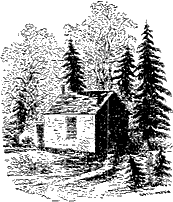
Drawing of Thoreau's cabin by his sister Sophia
Lesson 1: The life and times of Thoreau
Lesson 2: Thoreau's philosophy of government
Lesson 3: Thoreau's writing style
Lesson 4: Imprisonment and individuality
Lesson 2: What is H. D. Thoreau’s philosophy of government?
Instructional Objectives: Students will be able to read with understanding part of the essay “On Civil Disobedience” that deals with Thoreau’s philosophy of government. They will be able to work in groups to paraphrase two of Thoreau’s criteria for his beliefs. Individually they will be able to write a persuasive argument defending their own opinion on Thoreau’s beliefs. They will use technology to organize their writing and survey the opinions of their peers.
Time: One forty minute class (Allot more time for extension activities).
Motivation:
Marching
Boycotting
Legal action, e.g., lawsuit
Striking
Breaking the law, e.g., defacing property
The students are directed to define these words and phrases in the second column in terms of how they are used in protests and to give an actual example if they know one in the third column. In the fourth and fifth columns, the students indicate if they would be willing to participate in such a protest for a cause they believe in, both as part of a group and individually.
The answers are examined in a brief class discussion. Here is an example of how a completed worksheet might look.
Development:
- A student is asked to read the introduction aloud.
- Then the vocabulary is reviewed.
|
Expedient: a means to an end Inexpedient: of no use in bringing about a desired result Objection: an argument in opposition Prevail: to triumph |
- The teacher reads the following part of the essay as students read along. Note: the entire essay may be read at http://sunsite.berkeley.edu/Literature/Thoreau/CivilDisobedience.html
- The teacher lets the students know that the opening motto “That government is best which governs least.” is often quoted and used to defend the principles of individual rights and government conservatism. The students are directed to review the third paragraph in pairs and note the two major arguments Thoreau uses to defend this position.
- The two reasons for minimal government rule are reviewed.
Homework:
Extension: The results of the "motivation" may be polled, tallied, and graphed to report the results of students’ reactions to protesting in a group and individually.
- To quickly create a free online poll, try HTML gear from Lycos:
http://htmlgear.lycos.com/specs/poll.html
- Or, take a hand count of the class answers and have students enter data in either an Excel spreadsheet or using an online graphing center such as the National Center for Education Statistics "Create a Graph" site: